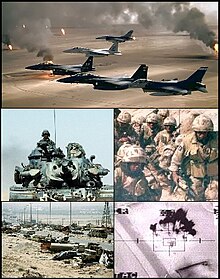Gulf War
| Gulf War | |||||||
|---|---|---|---|---|---|---|---|
 | |||||||
| |||||||
| Belligerents | |||||||
|
Diplomatic support : |
| ||||||
| Commanders and leaders | |||||||
|
|
| ||||||
| Strength | |||||||
| 956,600, including 700,000 US troops[1][2] | 650,000 soldiers | ||||||
| Casualties and losses | |||||||
|
| ||||||
The Gulf War was a conflict between Iraq and 39 other countries, led by the United States. It started with the invasion of Kuwait by Iraq on August 2, 1990. Iraq had claimed Kuwait as part of its territory. Iraq is said to have suffered around 80,000-100,000 soldier losses.[3]
There were two military operations.
Operation Desert Shield brought troops to protect Dhahran, Saudi Arabia and the Gulf states that Iraq had not attacked.
Operation Desert Storm attacked Iraq's forces both in Kuwait and in Iraq. It started on 17 January, 1991 with an air strike. Ground operations started 24 February. Iraqi forces set fire to oil wells to slow the attack. The war ended on 28 February, 1991 with a ceasefire.[4]
The long Iran–Iraq War had ended in August 1988. Iraq owed a great amount of money to Saudi Arabia and had difficulty paying it back. Saddam Hussein declared the neighboring country of Kuwait to be siphoning Iraqi crude oil from across the border, and on August 2nd, 1990 the Iraqi invasion of Kuwait started. On January 17, 1991 the US began the Persian Gulf War with a massive US led air offensive known as Operation Desert Storm.[5]
The attacks were assisted by newly developed weapons, including stealth aircraft, cruise missiles and smart bombs.
After 42 days of fighting U.S. President Bush declared a ceasefire on February 28. By that time most Iraqi forces in Kuwait had either surrendered or fled.
Operation Desert storm included a bombing campaign that targeted Iraqi aircraft, anti-aircraft systems, oil refineries, weapon factories, bridges, and roads. President George Bush decided not to depose Saddam Hussein.
Political issues after Operation Desert Storm lead to the second Persian Gulf War in 2003.

Related pages
[change | change source]References
[change | change source]- ↑ Gulf War coalition forces (latest available) by country "www.nationmaster.com". Archived from the original on 5 November 2013. Retrieved 2007-09-13.
{{cite web}}: CS1 maint: bot: original URL status unknown (link) - ↑ Hersh, Seymour (2005). Chain of Command. Penguin Books. p. 181.
- ↑ Ufheil-Somers, Amanda (1991-07-11). "The Other Face of War". MERIP. Retrieved 2023-04-06.
- ↑ Brinkerhoff, John R.; Silva, Ted; Seitz, John (1992-05-18). "United States Army Reserve in Operation Desert Storm. Engineer Support at Echelons Above Corps: The 416th Engineer Command". Fort Belvoir, VA. doi:10.21236/ada277638.
{{cite journal}}: Cite journal requires|journal=(help) - ↑ Lopes, Maraisa (2009). Folha de S. Paulo (Thesis). Universidade Estadual de Campinas - Repositorio Institucional. doi:10.47749/t/unicamp.2009.442545.
- 1990 in Asia
- 1991 in Asia
- Cold War
- 1990s in Kuwait
- Wars involving Australia
- Wars involving Belgium
- Wars involving Canada
- Wars involving Egypt
- Wars involving France
- Wars involving Iraq
- Wars involving Italy
- Wars involving the Netherlands
- Wars involving New Zealand
- Wars involving Pakistan
- Wars involving Spain
- Wars involving Syria
- Wars involving the United Kingdom
- Wars involving the United States
- 1990 in the United States
- 1991 in the United States
- Conflicts in 1990
